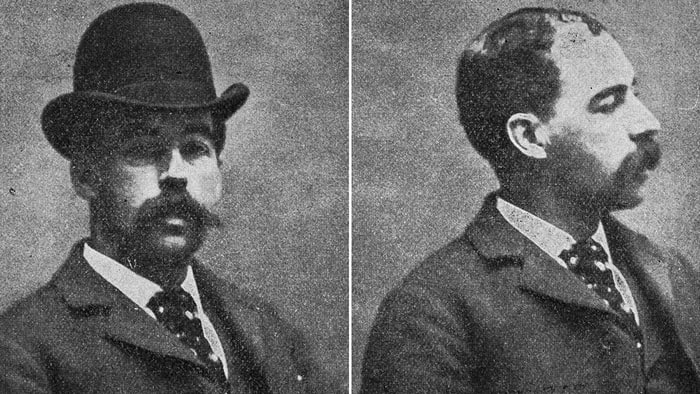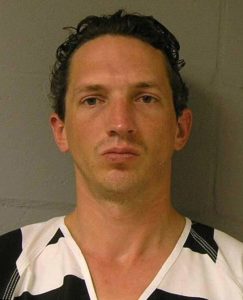Herman Webster Mudgett, commonly known as H. H. Holmes, was born in 1861 in New Hampshire.1 Mudgett was born into an affluent family and lived a very privileged life as a child. Many thought that Mudgett was unusually intelligent as a child; Mudgett showed an interest in medicine, which was one of the first signs of his psychotic behaviors, for Holmes practiced surgery on many helpless animals.2 Mudgett began his criminal life with petty acts of fraudulence and scams. One criminal act that Mudgett committed is haunting. Holmes stole corpses while as a medical student at University of Michigan in order to perform experiments on the bodies.3

Holmes later became one of America’s first serial killers. Mudgett is most commonly known for his brutal killer tactics in a specially constructed home nicknamed the “Murder Castle.” What flaws did he make? Who would commit such crimes? We are going to find out… Through criminology, specialists investigate the criminal’s mind, and acts of crime. What were the possible motives of H. H. Holmes and the flaws he made in his murders?
Mudgett was said to be an affluent, privileged child; although, there is more evidence to look for in his childhood years to show the cause of his crimes. Holmes’ mother was said to have had a terminal illness that traumatized the family. Many serial killers encounter psychological trauma early on in their life that creates a mental disorder leading to their twisted thoughts and actions. Mudgett’s mother’s illness could have been a possible cause for his psychotic behavior. Another could be that Mudgett’s mother was unable to be saved from her illness, so he wanted to join the medical field due to his hatred of doctors.
Mudgett was an extremely intelligent man, which makes him an even more terrifying figure. In 1885, Mudgett moved to Chicago and came across Elizabeth S. Holton’s drugstore at the southwest corner of South Wallace Avenue and West 63rd Street in Englewood, where he found work at a local pharmacy, and where he began using his infamous name, Dr. Henry H. Holmes.4 He worked at the pharmacy for about two years, and eventually took over the business. Holton said he proved himself to be a hardworking employee, and eventually bought the store.

With the money collected as the new owner of the local pharmacy, Holmes purchased an empty lot across from the drugstore, where construction began in 1887 on a two-story mixed-use building, with apartments on the second floor and retail spaces, including a new drugstore on the first floor.5 When Holmes declined to pay the architects or the steel company, they sued him in 1888. In 1892, he added a third floor, telling investors and suppliers that he intended to use it as a hotel during the upcoming World’s Columbian Exposition, though the hotel portion was never completed. Furniture suppliers found that Holmes was hiding their materials, for which he had never paid, in hidden rooms and passages throughout the building.6 Their search made the news, and investors for the planned hotel pulled out of the deal when a jeweler in the building showed them the articles.7 When the third floor caught fire on the night of August 13, 1893, only a few people were in the building, all employees and long-term residents. Holmes had taken out insurance policies on the building with at least four companies, all of which promptly sued rather than pay. During the 1893 Columbian Exposition, Holmes opened up his home as a hotel for visitors. Unfortunately, many guests did not survive what became known as the “Murder Castle.”8

Many of these victims were women who were seduced, lured into the “Murder Castle,” and then killed. Other victims were lured there by the offer of employment.9 Holmes did not live in Chicago for long, because many people began to catch on to his trail. With insurance companies pressing to prosecute Holmes for arson, Holmes left Chicago in July 1894 to construct another “castle” along the lines of his Chicago operation.10 If Holmes would have kept out of the many building issues of the Murder Castle, he might have been able to get away with more killings in Chicago.
In July 1894, Holmes was arrested for the first time, on the charge of selling mortgaged goods in St. Louis, Missouri.11 He was bailed out, but while in jail he met a convicted outlaw named Marion Hedgepeth, who was serving a 25-year sentence. The two planned a wild scheme to deceive an insurance company out of $10,000 by taking a policy out on Holmes and then faking his own death to receive the money. The plan became too elaborate and involved too many people, which meant a greater split of money among the group. Holmes became outraged and killed a member of the group, Benjamin Pitezel, and his entire family. Frank Geyer, a Philadelphia detective, found the decomposed bodies of the two Pitezel girls in the Pitezel house cellar after co-wrokers were suspicious that Mr. Pitezel had missed two days of work.12 After removing the bodies, Geyer noticed that one of the girl’s feet had been removed. After discovering that the girl had club foot, he theorized that the killer had cut off her feet to prevent a distinctive identification of the body.13 Holmes was reported to have visited a local pharmacy to purchase the drugs that he used to kill another member of the Pitezel family, and a repair shop to sharpen the knives he used to chop up the body before he burned it.14 The boy’s teeth and bits of bone were discovered in the home’s chimney. Holmes’ murder spree finally ended when he was arrested in Boston on November 17, 1894, after being tracked there from Philadelphia.15 In October 1895, Holmes was put on trial for the murder of Benjamin Pitezel, and was found guilty and sentenced to death.16 By then, it was evident that Holmes had also murdered the Pitezel children. Following his conviction, Holmes confessed to 27 murders in Chicago, Indianapolis, and Toronto.17 Holmes gave various contradictory accounts of his life, initially claiming innocence and later that he was possessed by Satan. On May 7, 1896, Holmes was hanged at the Philadelphia County Prison, for the murder of Pitezel family and countless other murders.18

All in all, Holmes let his impatient manner and greed get the best of him. If Holmes had been able to keep to himself, he would have been able to get away with more than he did. His motives were unclear, but the illness of his mother and his unhealthy interest in medicine have a strong correlation with the monster that was created in Chicago. Serial killers are a breed of monsters, and understanding the minds of a different breed is almost impossible. Relations and inferences can be made, but no one will ever understand why one would commit such crimes to another form of life.
- David Goldman, “Castle of Horror: The Gruesome Story of H.H. Holmes,” Biography 7, no. 5:28 (2003): 787. ↵
- David Goldman, “Castle of Horror: The Gruesome Story of H.H. Holmes,” Biography 7, no. 5:28 (2003): 789. ↵
- David Goldman, “Castle of Horror: The Gruesome Story of H.H. Holmes,” Biography 7, no. 5:28 (2003): 793. ↵
- George M. Ebehart, “New Publications,” College & Research Libraries News 64, no. 10: (2011) 680. ↵
- George M. Ebehart, “New Publications,” College & Research Libraries News 64, no. 10: (2011) 681. ↵
- George M. Ebehart, “New Publications,” College & Research Libraries News 64, no. 10: (2011) 681. ↵
- George M. Ebehart, “New Publications,” College & Research Libraries News 64, no. 10: (2011) 681. ↵
- Salem Press Encyclopedia Research Starters, 2016, s.v. “Mass and serial murders,” by Phyllis B. Gerstenfeld. ↵
- Salem Press Encyclopedia Research Starters, 2016, s.v. “Mass and serial murders,” by Phyllis B. Gerstenfeld. ↵
- Salem Press Encyclopedia Research Starters, 2016, s.v. “Mass and serial murders,” by Phyllis B. Gerstenfeld. ↵
- Salem Press Encyclopedia Research Starters, 2016, s.v. “Mass and serial murders,” by Phyllis B. Gerstenfeld. ↵
- Salem Press Encyclopedia Research Starters, 2016, s.v. “Mass and serial murders,” by Phyllis B. Gerstenfeld. ↵
- J.P. Shalloo, “Criminology,” Journal of Criminal Law and Criminology (2004), 333. ↵
- J.P. Shalloo, “Criminology,”, Journal of Criminal Law and Criminology (2004), 333. ↵
- J.P. Shalloo, “Criminology,” Journal of Criminal Law and Criminology (2004), 334. ↵
- J.P. Shalloo, “Criminology” Journal of Criminal Law and Criminology (2004), 334. ↵
- J.P. Shalloo, “Criminology,” Journal of Criminal Law and Criminology (2004), 334. ↵
- J.P. Shalloo, “Criminology,” Journal of Criminal Law and Criminology (2004), 334. ↵




92 comments
Jesus Parker
A really interesting read for me because I have heard about this “murder castle” before on the internet but never knew the whole story behind it. Terrible ending for the people Holmes had lured into the murder castle. It really makes one wonder what makes someone do what they do. Also interesting to find out about the man himself to see what type of guy he was and how he grew up.
Joanna Martinez
I very much enjoyed this article!!!! It was well written and very original. I never heard of H.H. Holmes before but ,through the articles, detailed stature understand the causes of his murderous ways. The trauma he encountered throughout his childhood caused him to have resentment towards other people. All of the events that occurred when he was young left him unhinged and most importantly unstable. Although personal trauma is not an excuse for killing numerous people, it does give us a pretty good comprehension of his mentality.
Andrew Petri
This article was very interesting and did a good job at delivering the information and backstory of H. H. Holmes. The backstory of him was very neat to see how the trauma when he was a child affected his whole perspective on life. Just because he had a traumatic experience and he got pleasure from killing, that does not excuse the actions that he took and the many lives that he ended.
Makenzie Santana
It hurts to know what traumatic experiences can do to a person. Holmes is no way excused for his actions in murdering innocents just for pleasure, but this article gave me a better understanding of what caused him to be a psychotic killer. It was interesting to hear about the infamous “Murder Castle” and how many people were foolishly lured there, making Holmes known as the first serial killer in the nation.
Bianca-Rhae Jacquez
Serial killers have been around for as long as anyone can remember. It is interesting to think about the first one ever because no one really thinks of how something so heinous began. Holmes had a “home” infamously known as the “Murder Castle” and that has to be one of the most chilling things a murderer could have. It is crazy to think that he was arrested for something completely different than murder because that’s how some people are caught these days.
Leeza Cordova
The Murder Castle was very interesting to hear about, and how many people were actually lured into there. It reminded me of a tv show called AHS that portrayed this idea a bit, in one of their seasons. The idea that childhood development can alter your future actions is very intersting to me, since many people do not grow up in the best way. I also was not aware that he was one of the first known serial killers, so this title caught my attention and made me want to read it.
Ava Rodriguez
This was a very interesting article. I had no idea this was the very first serial killer. It is so interesting to me to read these types of articles and finding out why they did what they did. Mr. Holmes had a very hard childhood which most likely contributed to the motivation to take another persons life.
Felicia Stewart
This article was very well written. The title of this article really caught my attention, especially because, I, personally, have always enjoyed reading the stories behind serial killers and what their motive was for doing such a thing. Also, how they possibly could have done such terrible things to so many people. One thing that I have seen in the background of many serial killers, including H. H. Holmes, is that they many times experienced hardships, especially growing up and in adolescence, and I find this to be interesting.
Danniella Villarreal
I’ve never read an article over the first serial killer, this was actually one of my favorite crime article I’ve read so far. It was very informative and well written. Mr. Holmes experienced trauma at such a young age that causes him to do the horrific actions he then did as an adult. Of course, this does not excuse his actions. Him killing a person’s entire family because of a plan that Homles had created in the first place is shocking.
Engelbert Madrid
The article was descriptive and well-written. The information that was given was clear, accurate, and significantly important to understand H. H. Holmes. In fact, I was drawn to this article, because the title caught my attention. Although crime articles are not my favorite, this article was interesting to read. I didn’t know about the first serial killer, and his background life was significantly essential to understand in order to know what things led Holmes to kill people.